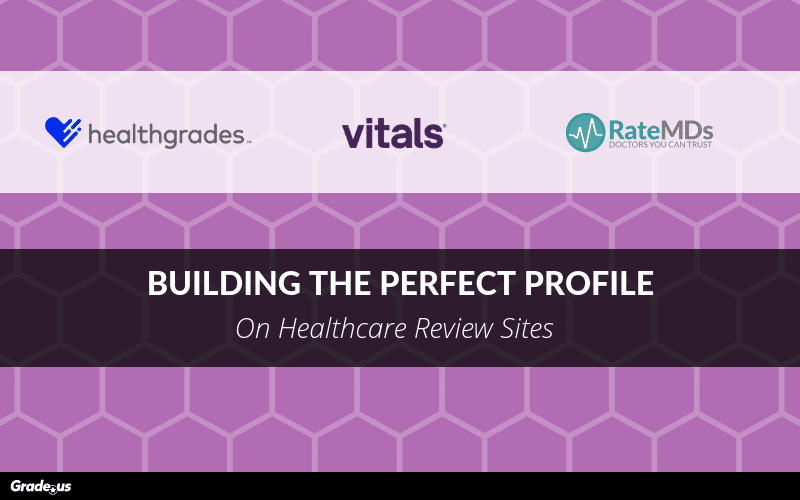Healthcare review sites can be a healthcare practitioner's best friend or worst enemy. And this reality isn't just about the reviews you'll receive on these sites (though the reviews do play a huge role).
It's also about your presence on these directories. Patients often search for doctors directly on these sites for information and reviews. Often, a doctor's profile is the one and only chance he or she has to make an impression. Patients may not ever visit the provider's primary web page before either calling to make an appointment or moving on.
If you want a steady flow of patients, you'll give these sites your full attention.
General Healthcare Review Site Advice
This advice applies to every profile you'll claim.
1. Get a professional headshot and post it. It is one of the surest ways to build trust with a potential patient.
2. Do not neglect any field you find on any site, especially practice areas and procedures. Sure, it may take awhile to enter in every practice area and procedure you perform on the regular, but it can really pay off. These serve as keywords and are referenced when patients run their search.
3. Triple check all your information is correct, and make sure the name, address, and phone number is exactly the same on every site. This is nitpicky: don't put Ste. 100 on one and Suite 100 on the other. These are called citations, and the more matching citations you have the better your search position on every site, including Google.
When you get your headshot you should go to someone who specializes in corporate, professional photos. A corporate headshot is a very different animal from a casual photo, a wedding photo, or even your family holiday portrait. And for a medical practice, the faces of the people who will be doing the work are literally the only photos which matter.
Healthgrades
Healthgrades is one of the number one sites for patients to find doctors. Their profiles are nice and attractive too, built to help you get an appointment straight out of their site.
If you're accepting new patients, say so.
Finding a new doctor is one of the biggest challenges for patients who are either moving into the area or who have gone without insurance for a long time and so never had a doctor to begin with. It's also challenging for patients who suddenly need specialists.
Nothing is more frustrating than having to call five or ten numbers just to find a single doctor who will let them book an appointment in a reasonable time frame. Healthgrades circumvents the problem.

These patients are where all your new revenue comes from. It's also where all your new reviews come from. Unless there's a really good reason not to, you're going to want to make sure the little green check mark is present and accounted for.
List out all insurance providers by name.
Healthgrades gives you all the space you could possibly need to do this, so don't get lazy. Writing "most insurances accepted" is not comforting to a patient who is extremely worried about whether his or her insurance will work at your practice.

Listing all the insurances is especially helpful when you accept obscure plans. Sure, everyone takes BCBS, but does everyone take Amerigroup?
Meanwhile, the physician who lists out every last one gives patients the exact information they're looking for, making it far more likely they'll go ahead and call.
The Care Philosophy field is a unique one you shouldn't ignore.
Your bio gives you plenty of opportunities to discuss your experience and background. But the "Care Philosophy" section is where you get to dig deep and be a human for a moment.

Make sure you consider what makes you unique as a provider and what your approach to medicine is. Spend a little time on this section, because it's going to tell patients a lot about the kind of care they can expect to receive.
Optional: Premium Profiles
Healthgrades offers you the ability to get a premium profile. These profiles are designed to look nicer and show up higher in the search results.

This screenshot shows you the difference between a premium listing (top) and a basic listing (on the bottom).
Premium profiles are worth considering. They tend to get more reviews and generate more patients than their basic counterparts. It's a matter of placement as much as aesthetics: premium results show up first, and many patients don't scroll much past the first three entries or so.
RateMDs
RateMDs isn't too different from the other sites. The only field which is new is the "Publications and Research" field; fill it out like you would any other field.
Getting the competitive edge on RateMDs is mostly just a matter of using it. For whatever reason, a lot of doctors haven't taken the time to claim their profile on this site. Get a photo and a bio up, fill out everything thoroughly, and enjoy the fact that you have a new source of potential appointments to work with.
Vitals
In terms of setting up or claiming your profile, this site is pretty much like the others. The layout is a little different, but that's about it.
Like Healthgrades, Vitals is selling premium profiles. Unlike Healthgrades, there's no way to tell if a profile is premium or not in the search results page. In fact, other than the "sponsored" notation in certain doctor's profiles, and the presumption these profiles appear on top, I haven't seen much difference between a premium profile and any other profile on the site.
What Vitals premium does offer is the Book an Appointment feature, which lets patients get an appointment with you right from your Vitals profile. This feature alone might be worth the upgrade unless you're not equipped to accept online appointments.

This feature makes setting an appointment super-convenient for patients, which means you get more appointments.
Other Sites
Though they aren't as big for physicians as the major healthcare review sites, you'll want to pay attention to Google My Business, Facebook, Yelp, and Zocdoc as well. Some patients have chosen out one of these sites to use for just about everything, and so you want to have all your information filled out and up-to-date on each of them.
But don't worry about using every last bell and whistle these sites have to offer. Here's why:
- Most people are not going to look for a podiatrist or an oncologist on Facebook.
- Yelp lists healthcare providers but is still more geared to businesses which are a little more fun, like restaurants.
- People do run Google searches on doctors but the kind of information they care about isn’t going to show up on a GMB profile. All the major medical review sites do show up in search results, and savvy patients know they’ll get more of the specialized information they care about on any of them. They might start with Google, but they’re going to move on.
Claiming all these profiles, filling in all the fields, writing up descriptions and posting photos. It's all time-consuming, and maybe even frustrating.
But if you take the time you'll stand out, and you'll do so in an industry where standing out is notoriously difficult. You only have to do this stuff once, or have it done for you.
Then you can get back to doing what you do best: taking care of your patients.
Need reviews for your practice?
Believe it or not, doctors and healthcare services need online reviews. Potential future patients are actually evaluating your practice based on your review portfolio.
That's where Grade.us comes in.
Create your review funnel today for free and start giving your happy patients a voice!
About the Author
Raney C. Hudson
Raney C. Hudson is an independent content consultant with a 10+ year track record in the digital marketing industry.










